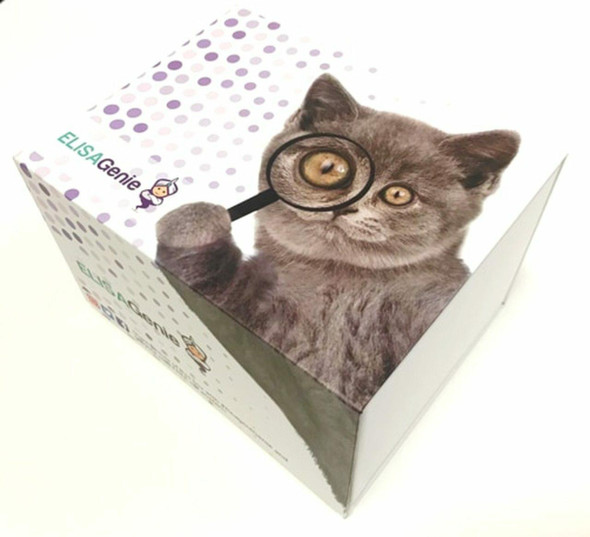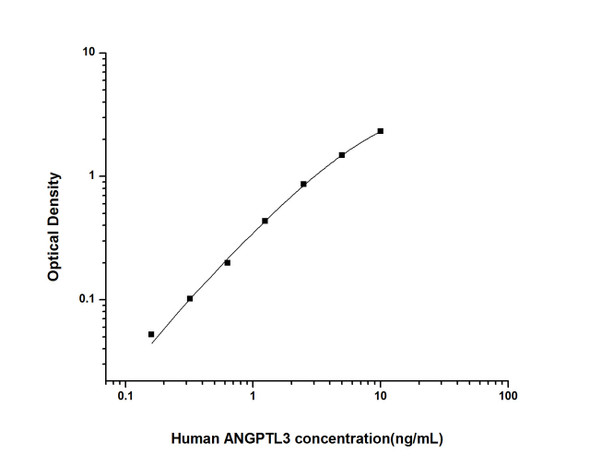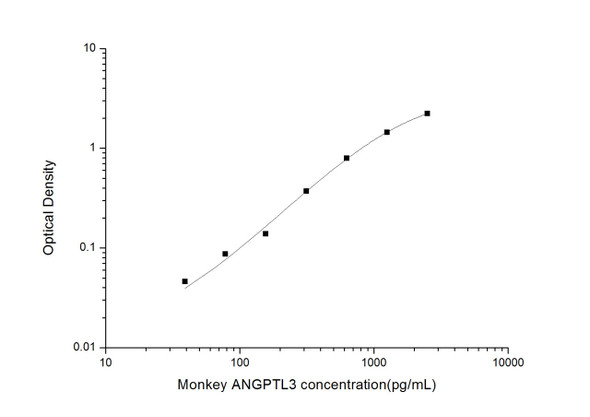Human Angiopoietin-like 3 / ANGPTL3 ELISA Kit (HUFI00433)
- SKU:
- HUFI00433
- Product Type:
- ELISA Kit
- Size:
- 96 Assays
- Uniprot:
- Q9Y5C1
- Sensitivity:
- 0.094ng/ml
- Range:
- 0.156-10ng/ml
- ELISA Type:
- Sandwich
- Synonyms:
- ANGPTL3, Angiopoietin Like Protein 3, AGNPT5, Ang-5, Angiopoietin-5, ANG-5, angiopoietin 5, angiopoietin-like 3, Angiopoietin-like protein 3, angiopoietin-related protein 3, ANGPT5angiopoietin-5, FHBL2
- Reactivity:
- Human
- Research Area:
- Cardiovascular
Description
Human Angiopoietin-like 3/ANGPTL3 ELISA Kit
The Human ANGPTL3 (Angiopoietin-like 3) ELISA Kit is a cutting-edge tool for the precise measurement of ANGPTL3 levels in human samples including serum, plasma, and cell culture supernatants. This kit offers exceptional accuracy, sensitivity, and specificity, ensuring trustworthy and consistent results for various research applications.ANGPTL3 is a key protein involved in lipid metabolism and regulation, making it a critical factor in conditions such as cardiovascular diseases, metabolic disorders, and liver diseases.
By accurately quantifying ANGPTL3 levels, researchers can gain valuable insights into the mechanisms underlying these diseases and potentially discover new therapeutic targets.Overall, the Human ANGPTL3 ELISA Kit is a valuable resource for scientists seeking to advance their understanding of lipid metabolism, cardiovascular health, and related disorders, ultimately paving the way for the development of innovative treatments and interventions.
| Product Name: | Human Angiopoietin-like 3 / ANGPTL3 ELISA Kit |
| Product Code: | HUFI00433 |
| Size: | 96 Assays |
| Alias: | ANGPTL3, Angiopoietin Like Protein 3, AGNPT5, Ang-5, Angiopoietin-5, ANG-5, angiopoietin 5, angiopoietin-like 3, Angiopoietin-like protein 3, angiopoietin-related protein 3, ANGPT5angiopoietin-5, FHBL2 |
| Detection method: | Sandwich ELISA, Double Antibody |
| Application: | This immunoassay kit allows for the in vitro quantitative determination of Human ANGPTL3 concentrations in serum plasma and other biological fluids. |
| Sensitivity: | 0.094ng/ml |
| Range: | 0.156-10ng/ml |
| Storage: | 4°C for 6 months |
| Note: | For Research Use Only |
| Recovery: | Matrices listed below were spiked with certain level of Human ANGPTL3 and the recovery rates were calculated by comparing the measured value to the expected amount of Human ANGPTL3 in samples. | ||||||||||||||||
| |||||||||||||||||
| Linearity: | The linearity of the kit was assayed by testing samples spiked with appropriate concentration of Human ANGPTL3 and their serial dilutions. The results were demonstrated by the percentage of calculated concentration to the expected. | ||||||||||||||||
| |||||||||||||||||
| CV(%): | Intra-Assay: CV<8% Inter-Assay: CV<10% |
| Component | Quantity | Storage |
| ELISA Microplate (Dismountable) | 8×12 strips | 4°C for 6 months |
| Lyophilized Standard | 2 | 4°C/-20°C |
| Sample/Standard Dilution Buffer | 20ml | 4°C |
| Biotin-labeled Antibody(Concentrated) | 120ul | 4°C (Protect from light) |
| Antibody Dilution Buffer | 10ml | 4°C |
| HRP-Streptavidin Conjugate(SABC) | 120ul | 4°C (Protect from light) |
| SABC Dilution Buffer | 10ml | 4°C |
| TMB Substrate | 10ml | 4°C (Protect from light) |
| Stop Solution | 10ml | 4°C |
| Wash Buffer(25X) | 30ml | 4°C |
| Plate Sealer | 5 | - |
Other materials and equipment required:
- Microplate reader with 450 nm wavelength filter
- Multichannel Pipette, Pipette, microcentrifuge tubes and disposable pipette tips
- Incubator
- Deionized or distilled water
- Absorbent paper
- Buffer resevoir
| Uniprot | Q9Y5C1 |
| UniProt Protein Function: | ANGPTL3: Defects in ANGPTL3 are the cause of familial hypobetalipoproteinemia type 2 (FHBL2); also called combined hypobetalipoproteinemia familial. FHBL2 is a disorder of lipid metabolism characterized by less than 5th percentile age- and sex-specific levels of low density lipoproteins, and dietary fat malabsorption. Affected individuals present with combined hypolipidemia, consisting of extremely low plasma levels of LDL cholesterol, HDL cholesterol, and triglycerides. |
| UniProt Protein Details: | Protein type:Secreted; Cell adhesion; Inhibitor; Motility/polarity/chemotaxis; Secreted, signal peptide Chromosomal Location of Human Ortholog: 1p31.3 Cellular Component: extracellular space; cell surface Molecular Function:integrin binding; enzyme inhibitor activity; phospholipase inhibitor activity; growth factor activity Biological Process: integrin-mediated signaling pathway; cholesterol metabolic process; phospholipid catabolic process; glycerol metabolic process; cell-matrix adhesion; lipid homeostasis; positive regulation of lipid catabolic process; fatty acid metabolic process; signal transduction; sequestering of lipid; positive regulation of angiogenesis; cholesterol homeostasis; acylglycerol homeostasis; phospholipid metabolic process; artery morphogenesis; negative regulation of lipoprotein lipase activity; positive regulation of cell migration; phospholipid homeostasis Disease: Hypobetalipoproteinemia, Familial, 2 |
| NCBI Summary: | This gene encodes a member of a family of secreted proteins that function in angiogenesis. The encoded protein, which is expressed predominantly in the liver, is further processed into an N-terminal coiled-coil domain-containing chain and a C-terminal fibrinogen chain. The N-terminal chain is important for lipid metabolism, while the C-terminal chain may be involved in angiogenesis. Mutations in this gene cause familial hypobetalipoproteinemia type 2. [provided by RefSeq, Aug 2015] |
| UniProt Code: | Q9Y5C1 |
| NCBI GenInfo Identifier: | 25008126 |
| NCBI Gene ID: | 27329 |
| NCBI Accession: | Q9Y5C1.1 |
| UniProt Related Accession: | Q9Y5C1 |
| Molecular Weight: | ~ 54kDa |
| NCBI Full Name: | Angiopoietin-related protein 3 |
| NCBI Synonym Full Names: | angiopoietin like 3 |
| NCBI Official Symbol: | ANGPTL3Â Â |
| NCBI Official Synonym Symbols: | ANL3; ANG-5; FHBL2; ANGPT5Â Â |
| NCBI Protein Information: | angiopoietin-related protein 3 |
| UniProt Protein Name: | Angiopoietin-related protein 3 |
| UniProt Synonym Protein Names: | Angiopoietin-5; ANG-5; Angiopoietin-like protein 3 |
| Protein Family: | Angiopoietin-related protein |
| UniProt Gene Name: | ANGPTL3Â Â |
| UniProt Entry Name: | ANGL3_HUMAN |
*Note: Protocols are specific to each batch/lot. For the correct instructions please follow the protocol included in your kit.
Before adding to wells, equilibrate the SABC working solution and TMB substrate for at least 30 min at 37°C. When diluting samples and reagents, they must be mixed completely and evenly. It is recommended to plot a standard curve for each test.
| Step | Protocol |
| 1. | Set standard, test sample and control (zero) wells on the pre-coated plate respectively, and then, record their positions. It is recommended to measure each standard and sample in duplicate. Wash plate 2 times before adding standard, sample and control (zero) wells! |
| 2. | Aliquot 0.1ml standard solutions into the standard wells. |
| 3. | Add 0.1 ml of Sample / Standard dilution buffer into the control (zero) well. |
| 4. | Add 0.1 ml of properly diluted sample ( Human serum, plasma, tissue homogenates and other biological fluids.) into test sample wells. |
| 5. | Seal the plate with a cover and incubate at 37 °C for 90 min. |
| 6. | Remove the cover and discard the plate content, clap the plate on the absorbent filter papers or other absorbent material. Do NOT let the wells completely dry at any time. Wash plate X2. |
| 7. | Add 0.1 ml of Biotin- detection antibody working solution into the above wells (standard, test sample & zero wells). Add the solution at the bottom of each well without touching the side wall. |
| 8. | Seal the plate with a cover and incubate at 37°C for 60 min. |
| 9. | Remove the cover, and wash plate 3 times with Wash buffer. Let wash buffer rest in wells for 1 min between each wash. |
| 10. | Add 0.1 ml of SABC working solution into each well, cover the plate and incubate at 37°C for 30 min. |
| 11. | Remove the cover and wash plate 5 times with Wash buffer, and each time let the wash buffer stay in the wells for 1-2 min. |
| 12. | Add 90 µl of TMB substrate into each well, cover the plate and incubate at 37°C in dark within 10-20 min. (Note: This incubation time is for reference use only, the optimal time should be determined by end user.) And the shades of blue can be seen in the first 3-4 wells (with most concentrated standard solutions), the other wells show no obvious color. |
| 13. | Add 50 µl of Stop solution into each well and mix thoroughly. The color changes into yellow immediately. |
| 14. | Read the O.D. absorbance at 450 nm in a microplate reader immediately after adding the stop solution. |
When carrying out an ELISA assay it is important to prepare your samples in order to achieve the best possible results. Below we have a list of procedures for the preparation of samples for different sample types.
| Sample Type | Protocol |
| Serum | If using serum separator tubes, allow samples to clot for 30 minutes at room temperature. Centrifuge for 10 minutes at 1,000x g. Collect the serum fraction and assay promptly or aliquot and store the samples at -80°C. Avoid multiple freeze-thaw cycles. If serum separator tubes are not being used, allow samples to clot overnight at 2-8°C. Centrifuge for 10 minutes at 1,000x g. Remove serum and assay promptly or aliquot and store the samples at -80°C. Avoid multiple freeze-thaw cycles. |
| Plasma | Collect plasma using EDTA or heparin as an anticoagulant. Centrifuge samples at 4°C for 15 mins at 1000 × g within 30 mins of collection. Collect the plasma fraction and assay promptly or aliquot and store the samples at -80°C. Avoid multiple freeze-thaw cycles. Note: Over haemolysed samples are not suitable for use with this kit. |
| Urine & Cerebrospinal Fluid | Collect the urine (mid-stream) in a sterile container, centrifuge for 20 mins at 2000-3000 rpm. Remove supernatant and assay immediately. If any precipitation is detected, repeat the centrifugation step. A similar protocol can be used for cerebrospinal fluid. |
| Cell culture supernatant | Collect the cell culture media by pipette, followed by centrifugation at 4°C for 20 mins at 1500 rpm. Collect the clear supernatant and assay immediately. |
| Cell lysates | Solubilize cells in lysis buffer and allow to sit on ice for 30 minutes. Centrifuge tubes at 14,000 x g for 5 minutes to remove insoluble material. Aliquot the supernatant into a new tube and discard the remaining whole cell extract. Quantify total protein concentration using a total protein assay. Assay immediately or aliquot and store at ≤ -20 °C. |
| Tissue homogenates | The preparation of tissue homogenates will vary depending upon tissue type. Rinse tissue with 1X PBS to remove excess blood & homogenize in 20ml of 1X PBS (including protease inhibitors) and store overnight at ≤ -20°C. Two freeze-thaw cycles are required to break the cell membranes. To further disrupt the cell membranes you can sonicate the samples. Centrifuge homogenates for 5 mins at 5000xg. Remove the supernatant and assay immediately or aliquot and store at -20°C or -80°C. |
| Tissue lysates | Rinse tissue with PBS, cut into 1-2 mm pieces, and homogenize with a tissue homogenizer in PBS. Add an equal volume of RIPA buffer containing protease inhibitors and lyse tissues at room temperature for 30 minutes with gentle agitation. Centrifuge to remove debris. Quantify total protein concentration using a total protein assay. Assay immediately or aliquot and store at ≤ -20 °C. |
| Breast Milk | Collect milk samples and centrifuge at 10,000 x g for 60 min at 4°C. Aliquot the supernatant and assay. For long term use, store samples at -80°C. Minimize freeze/thaw cycles. |






